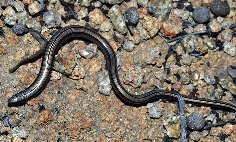San Diegan Legless Lizard (Anniella stebbinsi)
Description: The Southern California legless lizard is small and slender, with no legs, a shovel-shaped snout, smooth shiny scales, and a blunt tail. On close observation, eyelids are also present, making clear that the species are lizards and not snakes. Its dorsum is light olive-brown, with strong yellow sides, and its ventral colour is moderate yellow. It also has a black mid-dorsal stripe with the length of less than one scale wide that stretches from the parietals to the tip of the tail, and multiple black stripes that are one scale wide from the eye to the tip of the tail. The holotype is adult female measuring 5.2 inches in snout–vent length with 3.2 inches regenerated tail.
Habitat: legless lizards are found in a wider range of habitats than any other species in the genus, mostly found in coastal sand dunes and a variety of interior habitats, including sandy washes and alluvial fans. They live mostly underground, burrowing in the loose, sandy soil.
Range: Range includes southwestern California south of the Transverse Ranges, with disjunct populations to the north in the Tehachapi Mountains and Piute Mountains, and northwestern Baja California; south to Arroyo Pabellon, northwestern Baja California, and inland in Baja California to at least La Rumarosa north of the Sierra Juarez; also Los Coronados and Todos Santos islands in Baja California. Elevational range extends from sea level to at least 900 meters.
Continuous sandy habitat extends along Caliente Creek between Caliente Post Office and the Sand Ridge Preserve, the type locality for A. grinnelli. Additional fieldwork is needed to document the location of an almost certain contact between these two species. Contact between A. stebbinsi and A. pulchra is likely along the coast of California between the cities of Santa Barbara and Oxnard and along the southeastern slope of the Tehachapi Mountains, where A. pulchra is common in Joshua-tree/juniper woodland.
Found in these States:
CA
Diet: Eats primarily larval insects, beetles, termites, and spiders. Conceals itself beneath leaf litter or substrate then ambushes its prey.
Reproduction: The reproductive season begins with mating activities in late spring or early summer. The gestation period is about 4 months. Live young are born in September, October, or even November. Litter size ranges from one to four but two is common .
Status: Range extends from southwestern California to northwestern Baja California; dozens of extant occurrences, but much habitat has been lost/degraded by urbanization in southern coastal California; locally common in remaining habitat; continuing decline in extent and quality of habitat.
»» Kingdom: Animalia - Animals
»» Phylum: Chordata - Chordates
»» Subphylum: Vertebrata - Vertebrates
»» Class: Reptilia - Reptiles
»» Order: Squamata - Lizards
»» Family: Anniellidae - California Legless Lizards
»» Genus: Anniella
»» Species: Anniella stebbinsi - San Diegan Legless Lizard
This article uses material from the Wikipedia article "Anniella stebbinsi", which is released under the Creative Commons Attribution-Share-Alike License 3.0. Content may have been omitted from the original, but no content has been changed or extended.
|













